Over the years I’ve gotten tons of winter sowing questions. I see many of the same ones come through, so I decided to put together an FAQ (frequently asked questions) post to answer the most common ones. This is where you can find the answers you’re looking for all in one simple place.
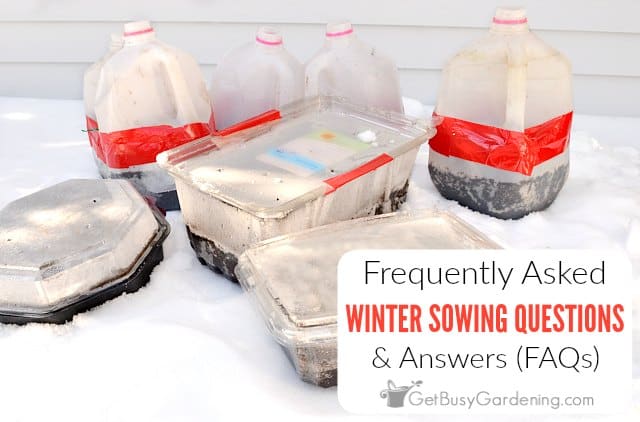
Below I’ve listed out the most common questions I get asked, or the ones I hear most often, along with a detailed answer for each one.
But before digging into the FAQs, I wanted to give you a list of resources where you might find the answer to your most burning winter sowing questions (if you can’t find it in this post).
Finding The Answer To Your WSing Question
If you’re brand new, or aren’t familiar with this technique, then start by reading my quick-start guide to winter sowing. There you’ll learn all about it, and how to get started.
Here are more articles that address many other common winter sowing questions that I get asked…
- When to start – If you’re wondering about the timing: when to begin, if it’s too late, or when to stop, then read this article about when to start (and stop) winter sowing.
- What types of containers to use – If you’d like to learn more about all the different materials you can use to make the mini greenhouses, then check out my complete guide for choosing the best winter sowing containers.
- Which seeds work best – If you’re unsure about which types of seeds will work, or you’d like a list of the ones to use to get you started, you can get my list of the best seeds to winter sow here.
- What kind of soil to use – If you’re wondering what kind of medium to use (and which ones to avoid), you can read all about how to choose the best soil for winter sowing here.

Frequently Asked Winter Sowing Questions & Answers
Below is the list of frequently asked questions about winter sowing that I get the most often.
If you can’t find your answer in this post, make sure to check out my full list of winter sowing articles here first. Otherwise, you can ask your question in the comments below.
Can I put my mini greenhouses in my porch instead of outside for the winter?
If the porch is screened in, they should be fine for the winter. But if your porch has windows, be careful of premature sprouting because of the greenhouse effect.
Also, since the containers won’t be outside, you will have to check on them, and water more often to make sure they don’t dry out.
You may also have to take an extra step to harden them off if it’s really warm in the porch.
How many seeds should I plant in each container?
You don’t want the seeds to be planted too close together, because that will make it more difficult to separate the seedlings.
But you don’t have to worry too much about spacing, since they won’t stay in the containers for too long.
As a general rule, I usually try to space my seeds about an inch apart. I give a little less space for small seeds, and I give the larger ones a bit more room.
Sometimes I plant them closer together if I have a few left over. For tiny seeds, I just sprinkle them over the top of the dirt.
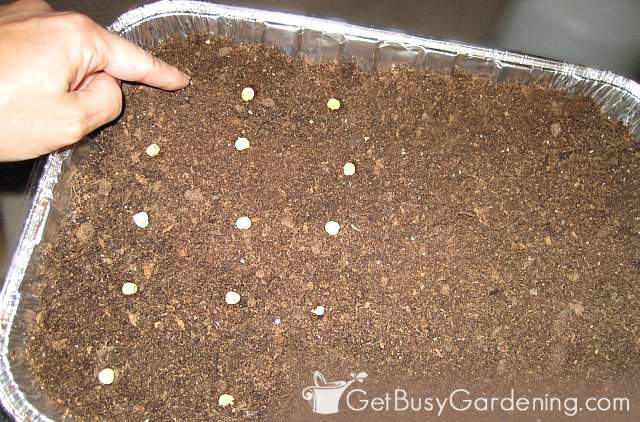
Will my seeds germinate in cold weather?
No. As long as it stays below freezing, your seeds will not germinate. It sounds funny, but they are programmed to know when it’s safe to start growing.
Won’t the constant freezing and thawing through the winter harm my seeds?
As long as you use the correct type of seed, then no. Winter sown seeds are going through the same treatment as the seeds that have sown themselves naturally in the ground.
In fact, some seeds even benefit from the freezing and thawing. It breaks down their hard outer shells, so we don’t have to worry about nicking them. And many of them even need the cold to grow.
Can I winter sow seeds in Dixie cups, toilet paper rolls, or egg cartons?
In case you’re not familiar, the idea is that the paper will make it easier to separate the seedlings in the spring. And that they will work as plantable pots that decompose in the garden.
I have experimented with this before, and found it didn’t work very well. The paper wicks water away from the soil, and dries it out very quickly.
Also, mold can grow on the paper, which is not ideal. Plus, the paper was so brittle by spring, it disintegrated and did not make it easier for me to separate the seedlings.
You could certainly try it to see how well it works for you. Just keep a close eye on the soil moisture level. If wicking becomes a problem, either remove the paper that’s sticking out, or cover it with more soil.
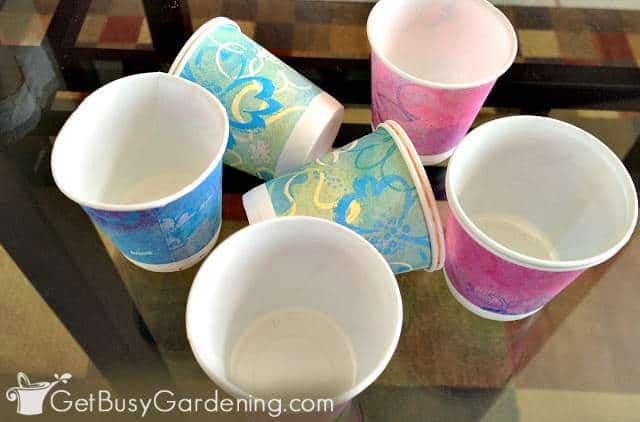
What should I do with my containers if it snows?
Nothing, let them get covered by snow. Don’t worry, it’s all part of the process, and it’s not going to crush the mini greenhouses or harm your seeds.
It’s nice because, as the snow melts, it will seep into the containers, keeping the soil moist.
In the spring after the snow melts off my containers, I go out there once in a while and toss more snow on top. That makes it super easy to water them.
Do I need to protect the containers from harsh cold if we don’t have snow to insulate them?
Nope. Put them out there in the freezing cold… and forget about them until spring. That’s the beauty of winter sowing.
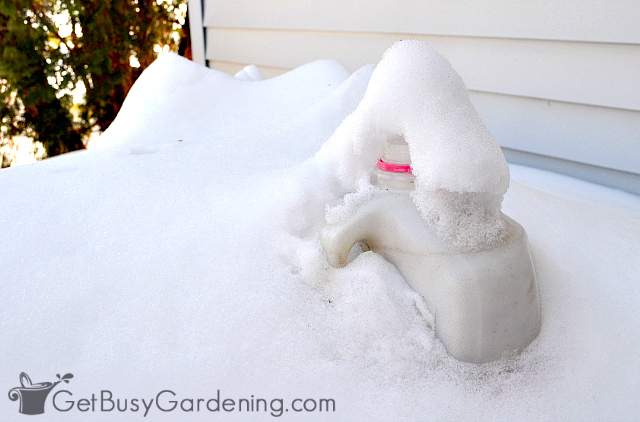
We have a big problem with squirrels and raccoons, will they bother my containers?
We have squirrels and raccoons too, and I’ve never had a problem with them getting into my containers.
If you’re too nervous to winter sow because of this, try putting out a few test containers, and see if any critters bother them.
I would think that since they are closed up tight, the critters will leave them alone. You could always leave the lids on your containers until you’re ready to plant the seedlings into the ground.
How do I water the containers?
If the containers are flat on top, you can just throw snow over them, or pour water onto the lids. This way, the water will trickle in through the vent holes.
For milk jugs, or similar containers, you can tilt them and slowly pour water into the top so it will trickle down the inside. If you pour water directly into the jug, you can displace the seeds or small seedlings.
If the lids are easy to remove, you can open them and water them like you would any other seedlings. But, this can be a big chore when you have lots of containers.
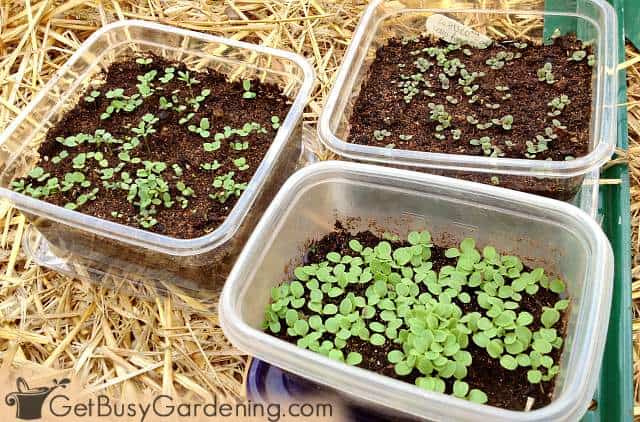
Should I be worried the mini greenhouses are getting too hot in the spring?
Yes. In my experience, this can be a problem. Those mini greenhouses can get pretty hot inside, and the seeds/seedlings could bake if you leave them in the full sun.
So, once it starts getting warm in the spring, you should protect them from the intense afternoon sun. You don’t want them to be in the shade all day, morning and/or evening sun are ideal.
Put your containers under a tree or shrub, or next to a fence, shed, or the house… anything that can provide some shade in the afternoon.
If a full sun location is your only option, then either add more holes in the top of the container, or open the lids to vent them.
Some of my seeds have germinated, but others have not, should I be worried?
Don’t worry, all of your seeds will not germinate at the same time. This is totally normal. Every type of seed is different, and some take longer to grow than others.
Germination rates will also likely vary from year to year. If it’s a warm spring they will germinate faster. If it’s cold, it will take longer. My best advice here is to be patient, and give it time.
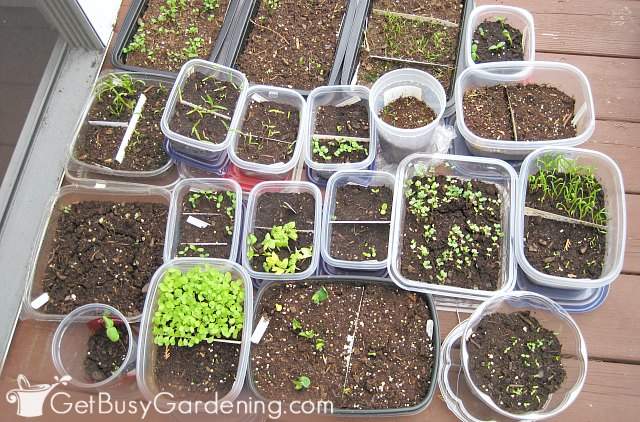
My seedlings are getting tall. Should I take the tops off or leave them on?
You can leave the tops on as long as you want, or take them off whenever you want. Some people leave the lids on until the day they plant the seedlings into the garden.
I take the lids off when the seedlings are outgrowing their containers. Sometimes I’ll take them off on a sunny day if I feel like it (which is not required), then I put the lids back on at night.
There are a few things to keep in mind once you remove the lids. If the seedlings are small, you should protect them from heavy rain.
Also, once the lids are off, the soil will dry out much quicker. So you’ll need to check on them at least once a day, and keep them well watered.
What should I do with the seedlings if it’s going to freeze?
Cold hardy winter sown seedlings can tolerate freezing temperatures, and shouldn’t need to be protected. Just keep the lids on your containers overnight, and they will be fine.
It’s the warm weather plants (the ones that can’t tolerate frost) that you’ll need to worry about. So you might want to give those seedlings a little extra protection to be safe.
Put the lids on the containers, and then cover them with a blanket. Or you could move them into the garage or a shed if that’s easier.
Last year I had all my lids off, and everything was growing great. Then one night in May, they were predicting a late freeze (ugh!).
I couldn’t put the lids back on because my seedlings were too tall, so I covered them with a blanket (and prayed).
Sure enough, the blanket was covered with frost the next morning. But, even without their lids, my seedlings were just fine under the blanket. Whew!
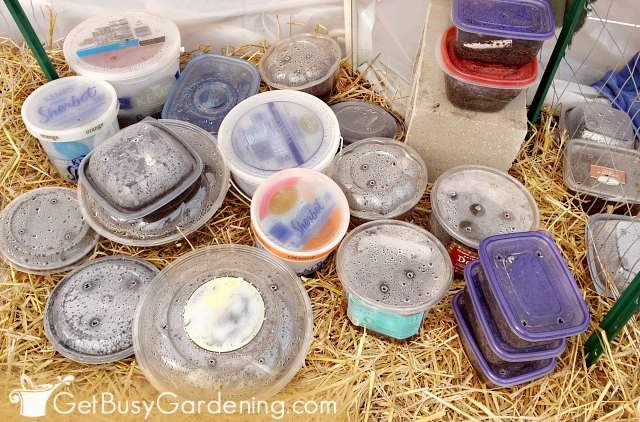
Hopefully this post answered all of your winter sowing questions. If not, you can go ahead and ask away in the comments below. Otherwise, click through the links to the articles at both the top and bottom on this page to find more information.
If you want to learn everything there is to know about winter sowing, then my Winter Sowing eBook would be perfect for you. It has all the details and steps you need to be a successful winter sower. Download your copy today!
Otherwise, if you want to learn all the different methods to grow any type of seed you want, then you should take in my Seed Starting Course. It’s a comprehensive, self-paced online course, and it’s lots fun too. Enroll and get started today!
More Winter Sowing Posts
- How To Prepare Containers For Winter Sowing
- Tips For Winter Sowing During A Mild Winter
- How To Clean Winter Sowing Containers For Reuse
Do you have any burning winter sowing questions? Go ahead and ask them in the comments below.
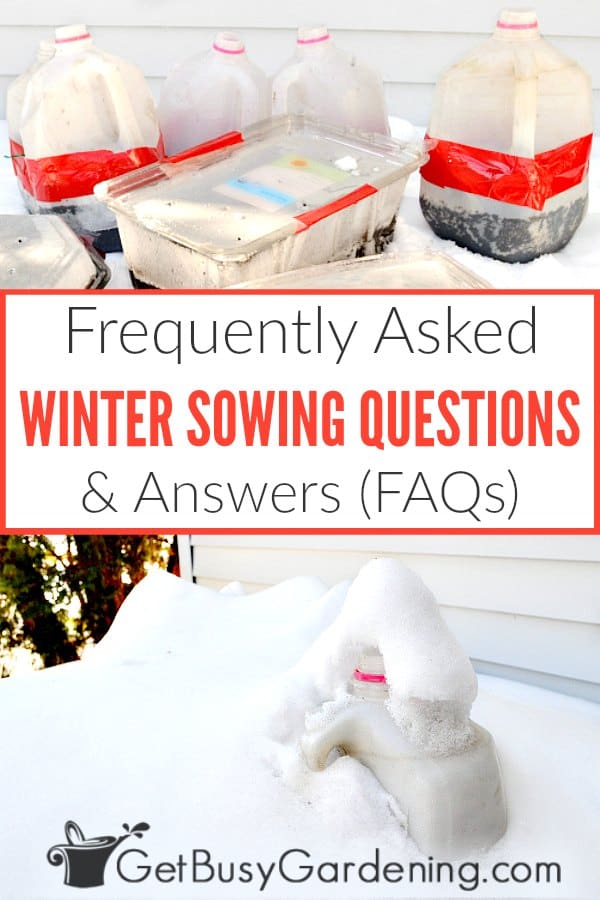
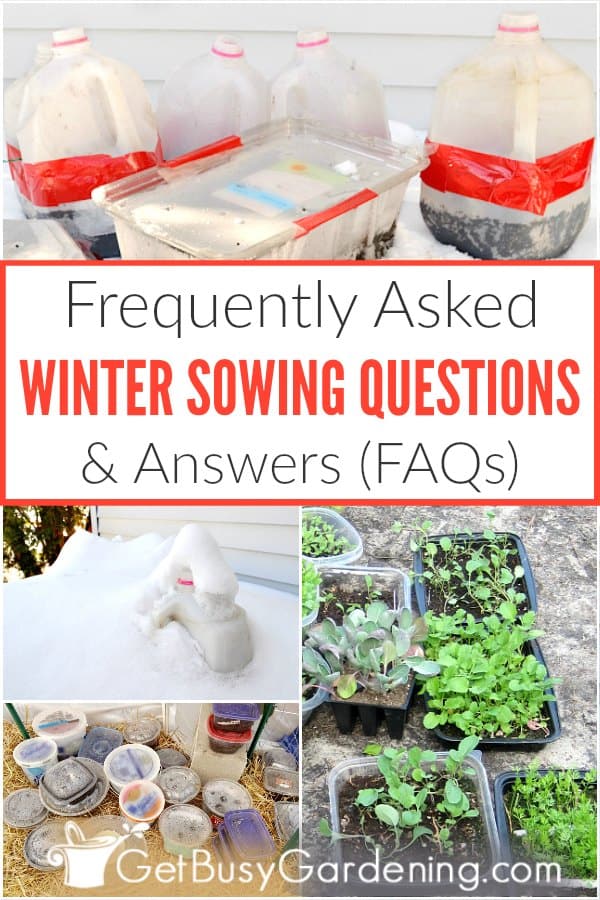
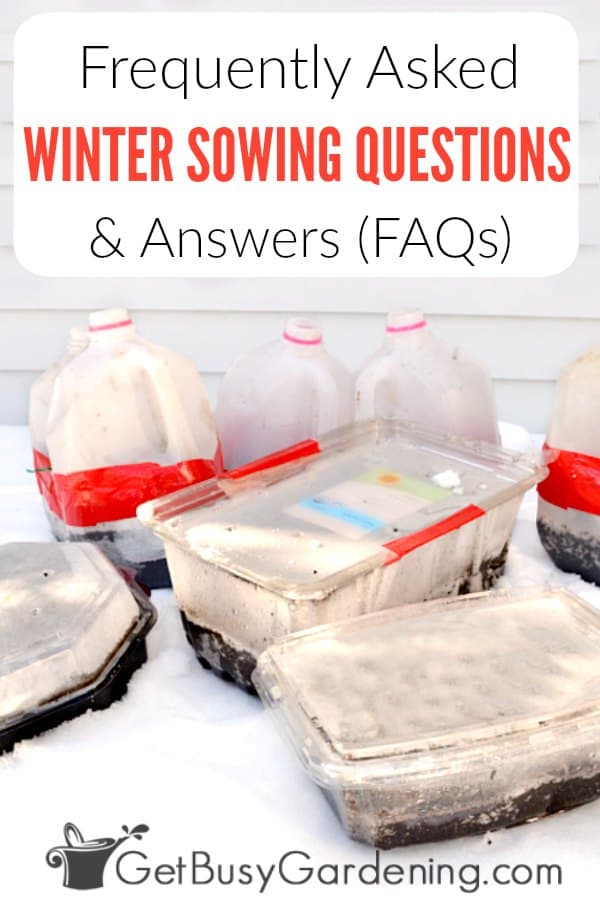

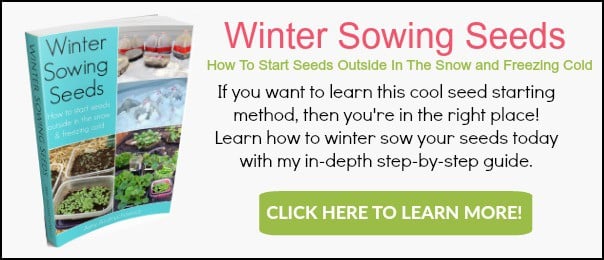

Cris says
Hi, we live in Arizona and in the mountains. January is our coldest month but we only sometimes get below freezing. Our lows are in the mid 30’s mostly. Is this cold enough? Our daytime highs can get to 50s….We are experiencing drought and snow can be hit or miss. Help
Amy Andrychowicz says
It doesn’t need to get below freezing or snow in order to use the winter sowing method, so you could definitely give it a try. However, if it is very dry, then you’ll need to check your containers regularly to make sure the soils stays moist, and water them if they start to dry out. It’s fun to experiment, so try it out and see how well it works in your climate! 🙂
Cris says
Thanks
Amy Andrychowicz says
You’re welcome. Have fun! 🙂
Chelsea says
Hi Amy! It’s almost mid March and I just read your article on winter sowing of seeds. Is it too late to start using this method now? I hope it isn’t because I think it sounds great and I want to get out there right now and get started! Thanks!
Amy Andrychowicz says
It depends on where you live. I’m in Minnesota (growing zone 4b), so I winter sow seeds through March, and even into April most years. The only caution you have to think about is if it gets warm in March and the seeds start to sprout, and then it gets really, really cold again – then you might have to protect some of your sprouting containers from the really harsh cold (it’s as easy as throwing a blanket over them on super cold nights). Read my post about when to start winter sowing for more details.
Chelsea says
Thanks Amy! I live in northeast PA and I think our winters are almost as cold as yours. At least this last winter was one of the worst in our area. I appreciate your answer so quickly. I think as a first time winter seed sower, I am going to take your advice and experiment! Thank you!
Amy Andrychowicz says
You’re welcome! Have fun experimenting. 🙂
Jennifer says
I’m just reading about winter sewing for the first time and I’m so excited! Could I winter sew in ct the first week of March? Thank you for your time!
Amy Andrychowicz says
You’re welcome. It depends on what type of seeds you want to try winter sowing. If the seeds need cold stratification, it may be too warm to start them in March. But otherwise, yes, many types of seeds will grow just fine using the winter sowing method as late as March. Read my post about when to start winter sowing for more details.
April says
I would love to use this method to start morning glory seeds. I have read that they don’t like being transplanted. What would you think about using a milk jug with an open bottom, cut in half like you do, placed at the site where I want the morning glories to grow? I would remove the top in the spring so they could root in place in the bottom half of the jug.
Amy Andrychowicz says
I have never tried that with any of my winter sowing before myself, but sounds like a genius idea and totally worth a try! Let me know how it works for you.
Nat White says
We are getting 60 f. days and even 70 occassionally in coastal Carolina. You suggest bringing mini greenhouse under shade. Should i just leave them there until Spring? I am holding off doing other seeds for a while.
Amy Andrychowicz says
You’re right to hold off until it gets cooler to do anymore winter sowing. Since you live so far south, it probably would have been better to wait longer to start, so keep that in mind for next year. Here’s a post to help with that… When To Start Winter Sowing Your Seeds. As for the ones that you’ve already started, yes, you can try putting them into the shade. However, if the temps continue to be that warm, they may start growing regardless. So just keep an eye on them, and hope for cooler weather! Good luck!
Heather Schlerf says
I put my winter sown jugs and containers in milk crates which prevents them from getting tipped over by critters and the high winds we have been having. It also makes it easier to move them from my deck in the Spring when the sun gets too intense and move them into an area where they won’t overheat.
Amy Andrychowicz says
Great idea, I bet that does make transporting all your WS containers much easier! Thanks for sharing your tip!
Diana says
Hi there,
I am just considering doing some winter sowing this year for the first time. I live in MI and am very intrigued by the process. I am planning on using some milk jugs. I am wondering if I am supposed to leave the lids on the jugs during the winter or not. Also I read that you suggest that peppers and tomatoes be started later during April or May, but what about eggplant, herbs and swiss chard? Thanks so much.
Amy Andrychowicz says
If by “lids” you mean the small cap the comes on top of the milk jugs, then no, you can toss those into the trash.
Eggplant would be in the same category as tomatoes. Swiss chard is a cold weather crop, so you can start that any time. As for herbs, it depends on the type. Some herbs, like basil, love warm weather, and I would wait to start them until closer to spring. Herbs like parsley, cilantro and dill are cold hardy, so they can be started any time. Here’s a post I wrote that has a list of seeds that do well with winter sowing… How To Choose The Best Seeds For Winter Sowing.
One thing to note: warm weather crops (i.e.: tomatoes, peppers, basil…etc) don’t always do great with this method. It depends on your zone. But here in z4b I’ve learned that they take too long to grow using the WS method, and I have gone back to starting these seeds inside. I always tell people to experiment with some seeds to see how they do in your zone. But don’t depend on this method for all your warm weather crops your first year of winter sowing.
Sue Gilmore says
How is winter sowing different from using a cold frame?
Amy Andrychowicz says
Great question! I think it’s very similar to using a cold frame (or cloches for that matter). The difference is that with winter sowing, you use recycled containers that are easy to get by anyone, and can be stored or recycled after the seedlings are planted. Cold frames take up more space, cost money to buy, and aren’t as portable.
Diane says
I live in Florida in the winter and return to SW colorado in the summer around mid June. I would love to plant seeds when i leave colorado in mid October and have them already growing in my garden by the time i get there in June. Otherwise it is much too late to start a new garden. With our short growing season, Is there a good way to try to do this . I thought about just planting seeds when I leave and hope for the best next summer. Would love to have scallions, beets, tomatoes, bell peppers and zucchini.
Amy Andrychowicz says
Winter sowing won’t be a good option for you because the containers do require maintenance during the spring to keep the seedlings watered and ventilated so they don’t overheat. Direct sowing seeds is going to be your best option. You could give it a try with the cold-hardy seeds. But the warmer weather ones (like most types of tomatoes, bell peppers, and zucchini) won’t survive the winter. It’s worth experimenting with it to see what grows and what doesn’t. Then you can just buy seedlings or plants for the other stuff.
Patti Law-Poggi says
My plants are up but we are in store for very low temps. Should i cover the jugs up?
Amy Andrychowicz says
It won’t hurt to cover the seedlings overnight to give them some extra protection. You could move them into a porch or garage overnight if you want too. But, cold hardy seedlings should be fine with just the lids on the containers.
Patti Law-Poggi says
When everything is ready to put out, do I place them in shade?
Amy Andrychowicz says
Nope, you put them in the sun.
Jim Kingsland says
Amy, I noticed you tape your milk jug containers all the way around. Others just use a strip of tape to hold the hinged top and bottom together. I expect there may be a trade off between airflow and moisture retention. Since my experience to date has been starting seeds indoors, and having no success due to damping off, I opted for more airflow. I understand there is much less risk of damping off with this outdoor method, but if fungi are at all possible, it would happen – thus my favoring airflow. Could you share your thoughts and experience on this? Thanks!
Amy Andrychowicz says
Yes, I started taping them all the way around to hold in the moisture. They were drying out too fast for me when I didn’t tape them all the way around. I’ve never had a problem with damping off in my winter sown containers. I always clean the containers before using or reusing them. You could give it a try, and if they start drying out too fast for you come spring, then you’ll know for next year. 🙂
Jim Kingsland says
Thank you so much for your quick and most helpful response! I am going to take your advice and tape them all around. I am using empty gallon sized distilled water jugs. I am so excited to follow and learn from you! You have given me the confidence to set out more jugs, and the hope and excitement maybe something will finally go right with my seed starting. I hope I can report back my success, but if not it’s beyond great to have an responsive expert helping me. Thank you
Amy Andrychowicz says
Awesome! So glad I could help. I hope your seeds will grow great for you this year! 🙂
Brittney says
I will definitely be getting my containers prepped and gathered this weekend! What a cool idea – I didn’t know I could do this. I’m in the Metro St. Louis area, so we get pretty cold here, but nothing like MN! If you can do this there, then there’s no reason I can’t get the head start down here – thank you for the info and tips! 🙂
Amy Andrychowicz says
Yes, awesome! Go for it, and have fun!
Kate says
Amy, just wondering how often you water your winter sown seeds, if at all?
Amy Andrychowicz says
You don’t need to worry about watering them when they’re under the snow, or frozen solid. But when it warms up in the spring, then they can start to dry out. I check on mine daily during dry spells, to see if they need water. Once the seedlings are out of the containers and planted in the garden, I treat them just like any other seedling/plant in the garden. Hope this answers your question.
Michael says
I haven’t done any winter sowing yet, although some of my best tomatoes and pumpkins have been volunteers accidentally left in the dirt over winter.
One of my biggest weaknesses in gardening is hardening off stuff I’ve planted inside, so I’ve been looking for options that would alleviate that pain. I think I’ll have to try winter sowing and see if I can kill less of my plants this year.
Amy Andrychowicz says
Great to hear! Yes, winter sowing eliminates the need to harden off your seedlings. You don’t have to baby them, and the seedlings are stronger and more likely to survive transplant to the garden. I’m glad you’re going to give it a try! Good luck and don’t hesitate to ask me any winter sowing questions you may have.
Wendy says
Amy, you live in Minneapolis? You know COLD!!! I lived in Dinky Town in the early 80s. Went to the U of M – loved the Twin Cities. Anyway, winter sowing is great fun and my arugula has sprouted which makes me crazy happy! I’m glad you’re creating a frenzy about winter sowing. I believe that many gardeners will not grow their own food because they are intimidated by seed starting, the equipment, failed attempts, all that. WS is just so easy and anytime people get their hands dirty, that’s good for all of us. I look forward to reading your blog. 🙂
Amy Andrychowicz says
Yes, born and raised! I hate the cold too, go figure. 🙂 I agree with you about people being discourage by starting seeds the traditional way. Winter sowing is great!